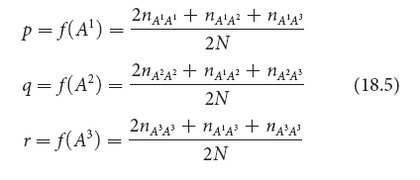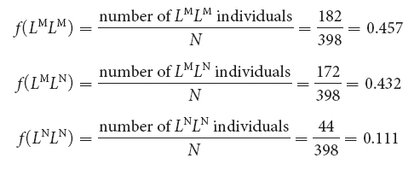Calculating Allelic Frequencies
The gene pool of a population can also be described in terms of allelic frequencies. There are always fewer alleles than genotypes, so the gene pool of a population can be described in fewer terms when allelic frequencies are used. In a sexually reproducing population, the genotypes are only temporary assemblages of the alleles. As described by Mendel’s principle of segregation, the genotypes break down each generation, and individual alleles are passed to the next generation through the gametes. Thus, the types and numbers of alleles, rather than genotypes, have real continuity from one generation to the next.
Allelic frequencies can be calculated from (1) the numbers or (2) the frequencies of the genotypes. To calculate the allelic frequency from the numbers of genotypes, we count the number of copies of a particular allele present among the genotypes and divide by the total number of all alleles in the sample:

For a locus with only two alleles (A and a), the frequencies of the alleles are usually represented by the symbols p and q. The frequencies can be calculated as follows:

where nAA, nAa, and naa represent the numbers of AA, Aa, and aa individuals, and N represents the total number of individuals in the sample. To obtain the number of copies of the allele in the numerator of the equation, we add twice the number of homozygotes (because each has two copies of the allele for which the frequency is being calculated) to the number of heterozygotes (because each has a single copy of the allele). We divide by 2N because each diploid individual has two alleles at a locus. The sum of the allelic frequencies always equals 1 (p + q = 1); so, after p has been obtained, q can be determined by subtraction: q = 1 − p.
472
Alternatively, allelic frequencies can be calculated from the genotypic frequencies. This calculation is useful if the genotypic frequencies have already been calculated and the numbers of the different genotypes are not available. To calculate allelic frequencies from genotypic frequencies, we add the frequency of the homozygote for each allele to half the frequency of the heterozygote (because half of the heterozygote’s alleles are of each type):

We obtain the same values of p and q whether we calculate the allelic frequencies from the numbers of genotypes (Equation 18.3) or from the genotypic frequencies (Equation 18.4). A sample calculation of allelic frequencies is provided in the next Worked Problem.  TRY PROBLEM 23
TRY PROBLEM 23
LOCI WITH MULTIPLE ALLELES We can use the same principles to determine the frequencies of alleles for loci with more than two alleles. To calculate the allelic frequencies from the numbers of genotypes, we count up the number of copies of an allele by adding twice the number of homozygotes to the number of heterozygotes that possess the allele and divide this sum by twice the number of individuals in the sample. For a locus with three alleles (A1, A2, and A3) and six genotypes (A1A1, A1A2, A2A2, A1A3, A2A3, and A3A3), the frequencies (p, q, and r) of the alleles are

Alternatively, we can calculate the frequencies of multiple alleles from the genotypic frequencies by extending Equation 18.4. Once again, we add the frequency of the homozygote to half the frequency of each heterozygous genotype that possesses the allele:

CONCEPTS
Population genetics concerns the genetic composition of a population and how it changes with time. The gene pool of a population can be described by the frequencies of genotypes and alleles in the population.
WORKED PROBLEM
The human MN blood-
| Phenotype | Genotype | Number |
| MM | LMLM | 182 |
| MN | LMLN | 172 |
| N | LNLN | 44 |
Source: W. C. Boyd, Genetics and the Races of Man (Boston: Little, Brown, 1950).
Calculate the genotypic and allelic frequencies at the MN locus for the Karjala population.
Solution Strategy
What information is required in your answer to the problem?
The genotypic and allelic frequencies of the population.
What information is provided to solve the problem?
The numbers of the different MN genotypes in the sample.
Solution Steps
The genotypic frequencies for the population are calculated with the following formula:


The allelic frequencies can be calculated from either the numbers or the frequencies of the genotypes. To calculate allelic frequencies from the numbers of genotypes, we add the number of copies of the allele and divide by the number of copies of all alleles at that locus:

To calculate the allelic frequencies from genotypic frequencies, we add the frequency of the homozygote for that genotype to half the frequency of each heterozygote that contains that allele:

 Now try your hand at calculating genotypic and allelic frequencies by working Problem 24 at the end of the chapter.
Now try your hand at calculating genotypic and allelic frequencies by working Problem 24 at the end of the chapter.